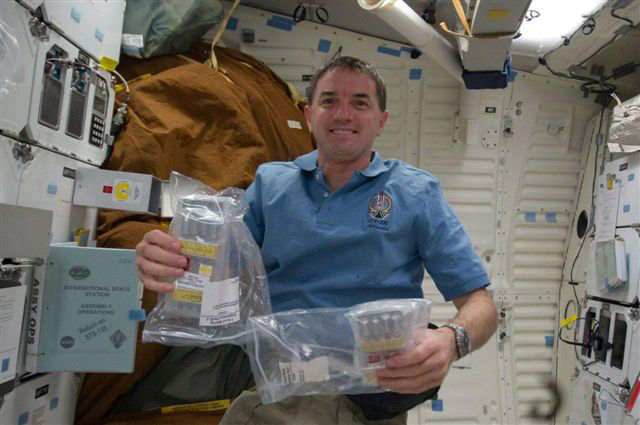Loss in Space

Atlantis and its sister space shuttles may be grounded for keeps, but the science they helped drive continues on ' and up.
On Atlantis' final mission in July, the Space Tissue Loss program, a partnership between NASA and the Department of Defense, sent up an experiment developed by Walter Reed Army Institute of Research in Silver Spring, Md. Its goal: To study human cellular response to bacteria in microgravity. Microgravity is notoriously hard on a body, speeding up muscle atrophy and bone-density loss. It also compromises the immune system.
"Prolonged residence at the space shuttle causes immunocompromization in the astronauts, for reasons nobody fully comprehends," said Dr. Rasha Hammamieh, principal investigator of the experiment and deputy director of Integrative Systems Biology at the U.S. Army Center for Environmental Health Research at Fort Detrick, Md. "Astronauts not only suffer from a delayed healing process, they also become particularly vulnerable to bacterial infection."
USACEHR, a subcommand of the U.S. Army Medical Research and Materiel Command, applies systems biology approaches to study such diseases. Working with Hammamieh on this study are co-investigator Dr. Marti Jett and colleagues Dr. Aarti Gautam and Nabarun Chakraborty.
Hammamieh hopes this experiment will help scientists understand specifically how to treat wounds during spaceflight and long space missions and in extreme environments on Earth. Central to the study are molecular signatures ' sets of genes, proteins, genetic variants or other variables that serve as early warning signals for disease.
"We expect the findings from microgravity to infer some 'blockers' of healing we have not necessarily been able to pinpoint relating to lack of healing in disease states on Earth," said Hammamieh. "This has the potential to lead to novel therapeutics and, perhaps even vaccines, against infectious diseases in the general public. Our research has potential benefits and applications both for life on Earth and astronauts on long-duration space missions."
Researchers have tried replicating the microgravity experiment on the ground, but shuttle experiments contradicted some of their results. Thus space remains the only reliable environment in which to study how microgravity affects cell growth and how cells fight off infections.
Hammamieh and her colleagues had mere months to prepare and pack the experiment aboard the Cell Culture Module, a wholly automated, temperature-controlled incubator system adapted for spaceflight and low Earth orbit. Developed by Hawaii-based Tissue Genesis, the CCM is essentially a lab in a box in which to study the effects of microgravity on cell cultures.
"Wound healing is a complex process, with many potential factors that can delay healing," explained Hammamieh. "All chronic wounds are colonized by bacteria. We are studying endotoxin-induced injury on dermal endothelial cells." Endotoxin is a bacterial toxin that inhibits certain host functions, opening the door to disease. "An endotoxin commonly associated with Gram-negative bacteria was injected into the test samples during the flight, and the reaction was stopped at two different time intervals. A solution was perfused into the cell chamber to preserve the cell responses."
Hammamieh's team will study the cell cultures at USACEHR's lab. It could take six months to generate data and another six to analyze the data and draw conclusions.
"With the evolving '-omics' approach in the field of science, we will be able to [generate] copious amounts of data at multiple levels of biology," said Hammamieh. "Transforming the findings of the present study into an effective therapeutic approach requires additional research steps."
But to conduct future studies in space, Hammamieh and fellow researchers will have to find a new ride, likely aboard Russian Soyuz space capsules. "The STL program surely has an international future," said Hammamieh, who sees opportunity in the coming changes. "For instance, over the years, Russia's Mir space station was covered by biofilm hosting microbes at microgravity. In fact, microbes were found in the water and air at the Mir space station, which further intensified the risk of having infection even from minor wounds. In this perspective, our study has a plausible future in the International Space Station Program."














